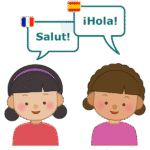The September 30, 2023, deadline to allocate ESSER II funding provided through the Coronavirus Response and Relief Supplemental Appropriations Act is quickly approaching! Here are five ways to use ESSER funding for your English learner (EL) program.
What is ESSER?
The Elementary and Secondary School Emergency Relief (ESSER) Fund is federal funding allocated through a series of acts and programs to help schools navigate the challenges of the COVID-19 pandemic. ESSER is a series of three different disbursements adding up to roughly $190 billion in funding for schools and districts. Funds are to be used for activities and items that are reasonable, necessary, and allocable, including activities and items allowable under the Every Student Succeeds Act (ESSA).
How Long Can ESSER Funding Be Used?
 Since March 2020, the federal government has marked nearly $190 billion to be spent on pandemic support and recovery for schools through ESSER. The deadline to allocate the first round of this funding was in September 2022, but schools still have until September 2023 to allocate funding from ESSER II and until September 2024 to create a plan for ESSER III funding. ESSER II allocates $54.3 billion, and ESSER III allocates roughly $122.7 billion––the largest amount of federal funding given to schools for pandemic relief thus far.
Since March 2020, the federal government has marked nearly $190 billion to be spent on pandemic support and recovery for schools through ESSER. The deadline to allocate the first round of this funding was in September 2022, but schools still have until September 2023 to allocate funding from ESSER II and until September 2024 to create a plan for ESSER III funding. ESSER II allocates $54.3 billion, and ESSER III allocates roughly $122.7 billion––the largest amount of federal funding given to schools for pandemic relief thus far.
Supporting Multilingual Learners with ESSER
The U.S. Department of Education has emphasized using ESSER funding to support student populations who have been disproportionately impacted by the pandemic, including students who are English learners (ELs). For example, reduced academic language usage during the pandemic adversely impacted ELs, as discussed in this article.
ESSER II and ESSER III funding can be used to enhance instructional supports for ELs in order to mitigate unfinished learning, accelerate learning and academic growth, and engage families and communities of ELs in order to improve language equity.
Here are five ways to use ESSER funding for your English learner program:
>1. Instructional Supports and Technology Improvements
 Use ESSER funds to purchase instructional materials and technology that support English learners. New personal devices, online language learning tools, and language building programs, such as Speak Agent, are all eligible. Speak Agent meets evidence criteria for ESSER with evidence-based programs for students in grades K-12. Our easy-to-implement programs can help schools raise both math and English language development (ELD) outcomes for multilingual learners. Enhancing the instructional supports and technology available to ELs can help them practice their skills and reinforce what they learn in the classroom.
Use ESSER funds to purchase instructional materials and technology that support English learners. New personal devices, online language learning tools, and language building programs, such as Speak Agent, are all eligible. Speak Agent meets evidence criteria for ESSER with evidence-based programs for students in grades K-12. Our easy-to-implement programs can help schools raise both math and English language development (ELD) outcomes for multilingual learners. Enhancing the instructional supports and technology available to ELs can help them practice their skills and reinforce what they learn in the classroom.
2. Professional Development
 ESSER funding can be used to provide professional development opportunities for teachers and staff who work with EL students. Professional development can help teachers improve their instructional strategies and better support EL students’ language and academic development. Teachers can learn how to incorporate culturally responsive teaching methods, use technology to support language acquisition, and create meaningful assessments that accurately measure English language proficiency.
ESSER funding can be used to provide professional development opportunities for teachers and staff who work with EL students. Professional development can help teachers improve their instructional strategies and better support EL students’ language and academic development. Teachers can learn how to incorporate culturally responsive teaching methods, use technology to support language acquisition, and create meaningful assessments that accurately measure English language proficiency.
3. Family Engagement Programs
 Implement family engagement programs with ESSER funding that involve parents and caregivers in their children’s education. Platforms and services that offer two-way translation can enhance parents’ involvement in their child’s learning, giving them better access to communications and resources to support their child’s ELD. These programs can help EL students and their families feel more connected to the school community, give parents skills to support ELD at home, provide information about EL programs and services within the school and district, and even connect families to adult English language learning programs available locally.
Implement family engagement programs with ESSER funding that involve parents and caregivers in their children’s education. Platforms and services that offer two-way translation can enhance parents’ involvement in their child’s learning, giving them better access to communications and resources to support their child’s ELD. These programs can help EL students and their families feel more connected to the school community, give parents skills to support ELD at home, provide information about EL programs and services within the school and district, and even connect families to adult English language learning programs available locally.
4. Mental Health and Behavioral Resources
 ESSER funding is targeted at supporting schools and students during recovery from the pandemic, particularly for underserved populations of students. One of the biggest challenges that schools are faced with today is helping students recover from various traumas, anxieties, and other mental health and behavioral struggles exacerbated by the pandemic. Investing in mental health and behavioral resources and services can connect students to the help they need. Ensuring these programs can reach multilingual learners is especially important because these students were disproportionately affected by remote learning and the pandemic.
ESSER funding is targeted at supporting schools and students during recovery from the pandemic, particularly for underserved populations of students. One of the biggest challenges that schools are faced with today is helping students recover from various traumas, anxieties, and other mental health and behavioral struggles exacerbated by the pandemic. Investing in mental health and behavioral resources and services can connect students to the help they need. Ensuring these programs can reach multilingual learners is especially important because these students were disproportionately affected by remote learning and the pandemic.
5. Tutoring and Intervention Programs
 Use ESSER funds to provide small-group tutoring and intervention services––including after-school and summer programs––to help ELs recover from pandemic learning loss and accelerate ELD. These services can be provided by certified teachers, paraprofessionals, or volunteers trained in working with ELs. The focus should be on providing targeted instruction that addresses the specific needs of each student in order to enhance ELD for multilingual learners.
Use ESSER funds to provide small-group tutoring and intervention services––including after-school and summer programs––to help ELs recover from pandemic learning loss and accelerate ELD. These services can be provided by certified teachers, paraprofessionals, or volunteers trained in working with ELs. The focus should be on providing targeted instruction that addresses the specific needs of each student in order to enhance ELD for multilingual learners.
As school and district leaders make plans to allocate remaining ESSER funding over the next 18 months, it’s critical to consider how these funds can best be invested to expand educational opportunities for English learners. Choosing the best ways to invest this funding will not only support multilingual learners and their needs today, but will also prove to be invaluable in terms of choices that positively affect generations of students to come.
Read Also:
Other Good Reads:
- ClassTech Tips Blog: How to Learn Math and Science with Language Support
- eSchool News: How a Major MD District Boosted Middle Math Achievement
- Digital Promise: Integrating Research-based Strategies into the Design of Educational Technology to Support All Learners





